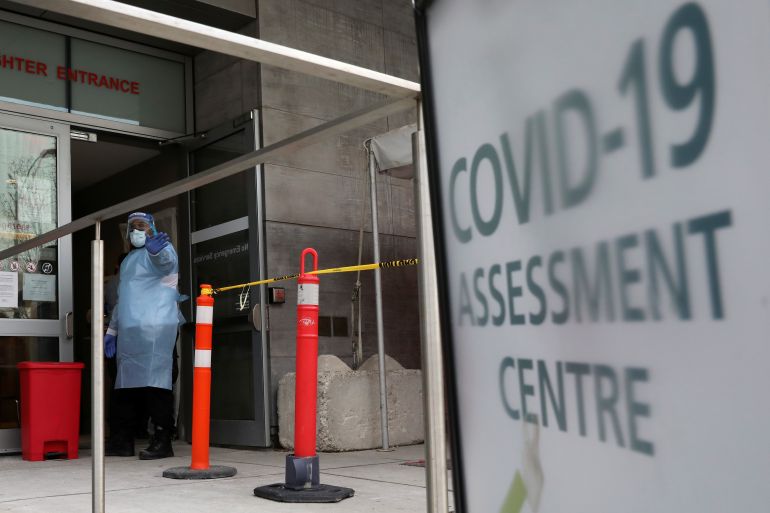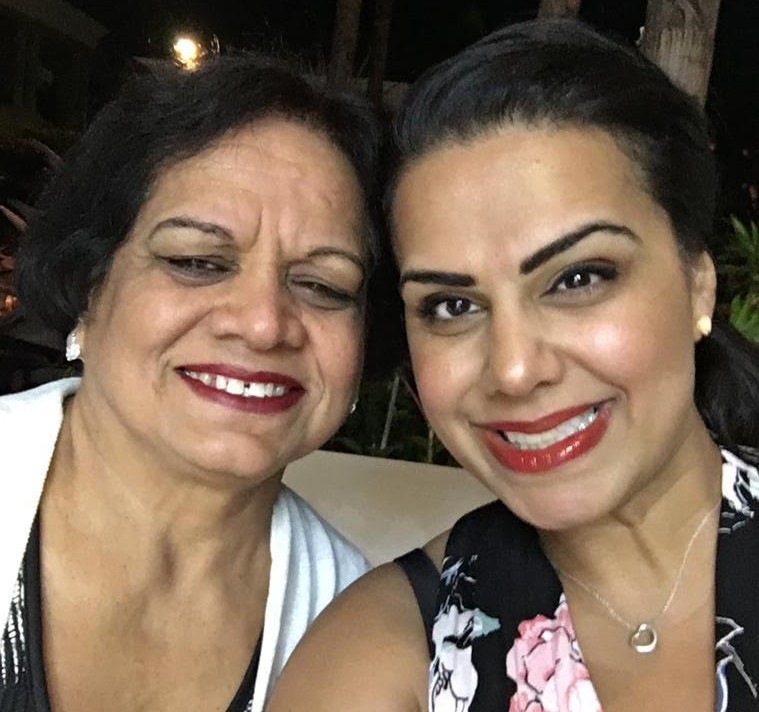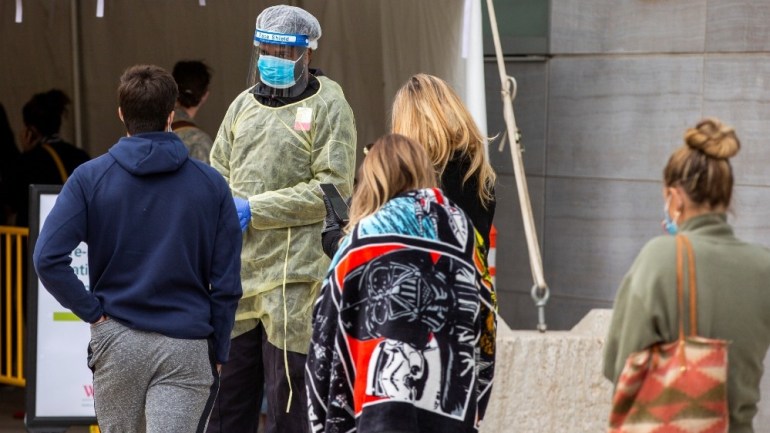Canada: Group boosts COVID messaging in South Asian communities
South Asian COVID Task Force aims to inform and advocate for marginalised community members hit hard by the novel coronavirus.

When Dr Simerpreet Sandhanwalia realised that COVID-19 testing centres were being under-used in communities with large South Asian populations in the Canadian province of Ontario, she enlisted her mother’s help.
Together, they made a social media video explaining the online testing registration process – in Punjabi. “It took many takes, and maybe a few arguments,” Sandhanwalia recalled, with a laugh, “but it got done.”
Keep reading
list of 3 itemsCanada: Is ‘me first’ COVID vaccine policy hurting other nations?
Canada sending military to remote First Nation hit by COVID-19
The response was immediate, said Sandhanwalia, an emergency room physician, and within 24 hours all the appointments were booked. “It wasn’t that people weren’t going out to get testing,” she said, “but accessibility and the ability to actually book an appointment was a big part of it.”

[Courtesy Dr Simerpreet Sandhanwalia]
Sandhanwalia is a member of the South Asian COVID Task Force, a group of South Asian physicians and health professionals in Canada that was formed last month to provide information to South Asian communities that have been hit hard by the virus.
She told Al Jazeera the goal is to amplify public health directives and make them more readily available and easier to understand for people whose first language is not English or French.
The task force sends out its messages on Instagram, TikTok and WhatsApp, the latter of which Sandhanwalia said is widely used by older generations, among other social media platforms.
A mix of infographics, testimonials from healthcare workers and skits can be found on the group’s Instagram account. “Stay home and stay safe” is the overarching message on many of the posts, which have hundreds of likes.
“It just started off with a few physicians that wanted to get the word out,” she said.
“Now, we’ve grown to include community members and leaders across different faiths and domains. We work together … to provide clear and concise messaging to the community that they will understand in order to curb this disease and control it.”
Disproportionate impact
Canada has recorded more than 495,000 cases of COVID-19 since the crisis began – and Ontario has the second-highest case and death totals in the country. On December 17, just days after the first Pfizer-BioNTech vaccines were administered in the country, the province reported a seven-day average of 2,026 new daily COVID-19 infections.
Reports show that racialised people across Canada are bearing the brunt of the virus due to several factors, including unequal access to health services and high levels of participation in front-line work deemed essential during the pandemic.
Workplace COVID-19 outbreaks account for about 28 percent of 880 active outbreaks in Ontario, according to provincial data. That is second only to outbreaks in long-term care centres, hospitals, and retirement homes, which account for about 32 percent of all active outbreaks.
We work together ... to provide clear and concise messaging to the community that they will understand in order to curb this disease and control it
The most recent figures from the public health agency of Toronto, Canada’s largest city with more than 2.9 million residents, showed that racialised people accounted for 77 percent of COVID-19 infections in the city as of October 31. The agency also said 70 percent of all people hospitalised due to COVID-19 were racialised.
Fifty-two percent of Toronto residents belong to a racialised group, according to the 2016 census.

“While COVID-19 has affected all of us, unfortunately, it has had a greater impact on those in our community who face greater health inequities,” Dr Eileen de Villa, Toronto’s medical officer of health, said in a statement in July when the city’s first race-based data was released.
‘Historically disadvantaged’
Ananya Tina Banerjee, an assistant professor at the Dalla Lana School of Public Health at the University of Toronto, said she knew South Asian communities would be hit hard by the novel coronavirus.
Residents of working-class areas in Brampton, Ontario, and Surrey, British Columbia, for example, are particularly vulnerable to COVID-19 because they often are engaged in precarious front-line work where they face a greater risk of infection, Banerjee told Al Jazeera.
According to the 2016 census, 261,705 residents of Brampton, northwest of Toronto, identified as South Asian – about 44 percent of the city’s total population – while 32 percent (a total of 168,040) of the residents of Surrey, near Vancouver, identified as South Asian.
“These are communities that have been historically disadvantaged and as a result [residents] are more often working as essential workers and in the front-line, with low wages and not having the chance to have paid sick days,” Banerjee said about the two communities.
One Brampton neighbourhood had a COVID-19 test positivity rate of 19 percent in early November, local media reported.
Ontario and BC have released guidelines and requirements for employers to ensure workplaces are safe and employees are protected against the potential spread of COVID-19 on the job.
But advocates said some workers – including those working on a temporary basis or those who do not have permanent immigration status in Canada – fear retaliation should they raise concerns about unheeded safety measures. Many workers also do not have paid sick days.
“We know that they’re in precarious work. It’s unaffordable for them to even take time off work and to get tested,” Banerjee said.
Scapegoating
People have raised increasing frustration in recent weeks about what they say has been the scapegoating of South Asian communities amid an uptick in infections.
South-Asian Canadians demanded an apology from Alberta Premier Jason Kenney last month after he suggested in a radio interview that the community’s large family gatherings were responsible for the spread of the virus.
Kenney’s office said the premier was not casting blame, but a Calgary city councillor, Jyoti Gondek, called on Kenney to back up his claims with evidence. “I don’t want to hear their opinions on where the spread is coming from when they have no facts to back them up and I’m really not interested in an apology,” Gondek said, as reported by CTV News.
This “South Asian” does not care for an apology. This Albertan wants a plan to assist those in higher risk employment, who then come home to their families. I want a strategy that includes tracing, rapid testing & mitigation measures.
Do your job, #AbLeg. https://t.co/4gWMTHM2Wc
— Dr Jyoti Gondek (@JyotiGondek) December 1, 2020
In the neighbouring province of BC, the top public health officer, Dr Bonnie Henry, said South Asian communities were being hit harder than others by COVID-19 and more protections were needed. She said large gatherings were a factor, but not the only one.
“Many people in the South Asian community live in Surrey and areas around there, and also own and work in many of the essential businesses that have kept our province going, whether it’s food-production or trucking or working in healthcare,” Henry said, according to local media.
Banerjee said that since the task force is composed of South Asian community members themselves, it can focus on peoples’ most pressing needs and dispel some false narratives around South Asians and the virus.
Concrete demands
Meanwhile, Sandhanwalia said members of the Task Force are making public health directives available in six languages spoken by members of South Asian communities: Punjabi, Hindi, Tamil, Urdu, Bengali, and Gujarati.
The group has also teamed up with local community groups, such as the Sikh World Organization, to help disseminate public health directives, dispel rumours and offer advice on best practices to stem the spread of the virus.
These are communities that have been historically disadvantaged and as a result (residents) are more often working as essential workers and in the front-line, with low wages and not having the chance to have paid sick days
Sandhanwalia said the group wants isolation centres to be created to give people living in multigenerational homes a place to go should they contract COVID-19, without fear of infecting their loved-ones. People also need financial support to be able to stay away from work as per health guidelines, if necessary, she said.
“The hospitals are bursting at the seams. There are so many sick people, not only from COVID but from other things that were always the case before: strokes, heart attacks,” Sandhanwalia said. “Our medical system will collapse if we do not get this under control.”
For her part, Banerjee said she hoped the task force would also expand to look at other health disparities South Asians experience in Canada, such as high rates of diabetes and less access to cancer screenings, which in turn can lead to worse outcomes.
The group, she said, is a welcome step to address underlying issues fuelling COVID-19.
“It’s not just COVID where the disparities lie,” she said. “It’s a long road ahead.”